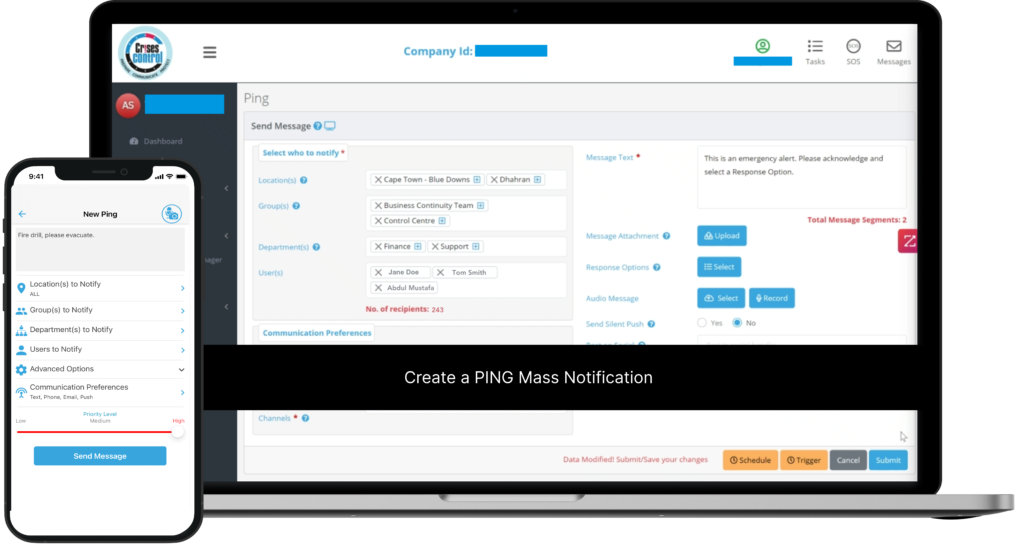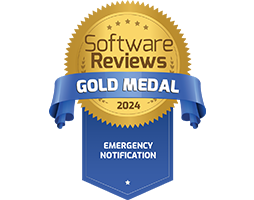Written by Anneri Fourie | Crises Control executive
Natural disasters are an unavoidable reality. Whether it’s a flood, earthquake, wildfire, or hurricane, businesses need to be ready to act quickly to protect their people and operations. Yet many organisations are still caught off guard, often because their communication systems break down when they’re needed most.
An effective Mass Notification System is not a luxury anymore — it’s essential. It’s one of the most important pillars of any disaster preparedness and business continuity plan. In this blog, we explore why mass notification systems are critical for resilience and how Crises Control offers one of the strongest solutions available.
The Rising Threat of Natural Disasters to Business Continuity
The damage caused by natural disasters goes far beyond physical destruction. Disrupted operations, broken supply chains, and communications failures can bring businesses to a standstill. According to the Global Risks Report, climate-related events are now some of the biggest threats facing organisations worldwide.
Despite this growing risk, many companies still rely on outdated, manual methods to alert their staff during a crisis. Relying on emails, phone trees, or ad-hoc text messages leads to confusion, slow reactions, and, in the worst cases, puts lives in danger.
A resilient business is not one that can avoid disasters, that’s rarely possible. It’s a business that can respond quickly and recover without missing a beat.
A Mass Notification System for natural disasters makes sure that even when chaos strikes, your lines of communication stay open, reliable, and fast.
What is a Mass Notification System?
A Mass Notification System (MNS) is a platform designed to deliver urgent messages to large groups of people at the same time, across multiple communication channels. These channels often include:
- SMS text messages
- Emails
- Voice calls
- Push notifications via mobile apps
- Desktop alerts
An Emergency Mass Notification System acts as the central nervous system of your emergency response. It ensures the right people get the right information at the right time, wherever they are.
Key features of a strong mass notification system include:
- Multi-channel message delivery: Reaching people through several communication routes at once
- Two-way communication: Letting recipients reply, confirm receipt, or request help
- Geo-targeted messaging: Sending alerts only to those in affected areas
- Real-time reporting: Tracking message delivery, acknowledgements, and responses
- System integration: Connecting with your existing HR, IT, and incident management platforms
Mass notifications aren’t just about sending alerts, they are about maintaining structure, direction, and clear decision-making during moments of high pressure.
Why a Mass Notification System is Vital for Natural Disaster Preparedness
When natural disasters strike, events move fast. There is little time to waste, and delays can cost lives. A Mass Notification System plays a vital role by:
1. Speeding Up Emergency Response
Every second counts during a disaster. A mass notification system allows organisations to instantly send out alerts and instructions, removing delays and making sure employees know exactly what to do without wasting time.
2. Reaching Dispersed Teams
Remote and hybrid working have spread workforces across towns, cities, and even countries. Traditional methods like office PA systems or internal emails aren’t enough anymore. Mass notification systems deliver critical updates to employees no matter where they are located.
3. Reducing Communication Gaps
Manual processes like call trees and mass emails create dangerous bottlenecks. Important messages can get delayed, lost, or misunderstood. A good mass notification system automates the entire process, ensuring consistency and cutting out human error.
4. Facilitating Two-Way Communication
Broadcasting information is only half the story. A strong response also relies on feedback. Mass notification platforms allow staff to confirm they are safe, report their status, or ask for assistance. This real-time feedback gives leadership the information they need to make better decisions.
5. Enabling Compliance and Accountability
In many industries, regulations require organisations to prove they have effective emergency communication processes. Mass notification systems offer detailed audit trails, showing who was contacted, when, and how they responded, vital for compliance reviews and post-incident investigations.
Integrating Mass Notification into Your Business Continuity Strategy
A mass notification system must fit neatly into your overall business continuity and disaster recovery plans. To make sure it does, follow these steps:
- Risk Assessment: Identify the natural disasters most likely to affect your business, based on your locations and operations.
- Scenario Planning: Prepare message templates and action plans for different disaster types, such as floods, earthquakes, or severe storms.
- Training and Simulations: Train staff regularly and run tabletop exercises to test how the system and procedures work under pressure.
- Integration with Incident Management: Connect your notification system to your wider incident management platform, creating a single, streamlined emergency response process.
- Automated Escalation Paths: Set up escalation processes so that if no response is received within a certain time, alerts are automatically sent to the next person in line.
A mass notification system is most effective when it’s fully woven into your emergency planning, not added as an afterthought.
How Crises Control Helps Build Resilient Businesses
At Crises Control, we believe that resilience starts with preparation, technology, and people. Our Mass Notification System is designed for organisations that need fast, reliable, and secure communication when it matters most.
Here’s what makes Crises Control different:
Ping Mass Notification System
Our Ping system delivers alerts instantly across SMS, emails, mobile app, voice calls, and desktop pop-ups. You can schedule alerts, automate triggers, and send messages based on specific roles, teams, or locations, ensuring the right people get the right information.
Geo-Targeted Communications
When a natural disaster strikes, you need to communicate with the people affected, not everyone in the company. Crises Control allows geo-targeting, reducing unnecessary alerts and improving response times.
Incident Management Integration
Mass notifications are only one part of a disaster response. With Crises Control, you can manage incidents end-to-end — from sending the first alert to coordinating the recovery — all from a single, easy-to-use dashboard.
Cloud-Based and Highly Available
Our platform is hosted on resilient cloud infrastructure, with 99.95% uptime. Even if your internal systems go down, Crises Control continues to operate. Our mobile app also allows you to manage incidents on the go, so you are never left powerless.
Real-Time Reporting and Post-Incident Review
With full visibility over message delivery, acknowledgements, and staff status, you stay in control during the crisis. After the event, detailed reports make it easy to review performance, meet regulatory requirements, and improve future responses.
Interested in our Ping Mass Notification System?
Efficiently alert everyone in seconds at scale with our Mass Notification System – PING, get the message out fast and ensure rapid response and recovery.

Conclusion: Resilience Starts with Communication
Natural disasters will happen. No business can prevent them. But what you can control is how you respond.
A reliable Mass Notification System doesn’t just send messages, it ensures your business reacts quickly, decisively, and effectively when the stakes are highest.
It keeps your people informed, your leadership teams in control, and your operations moving, even in the most difficult circumstances.
With Crises Control, you can transform your disaster response strategy and build a business that stands strong against whatever challenges come your way.
Contact us today to book a free personalised demo and find out how Crises Control can help safeguard your business during natural disasters.
Request a FREE Demo









